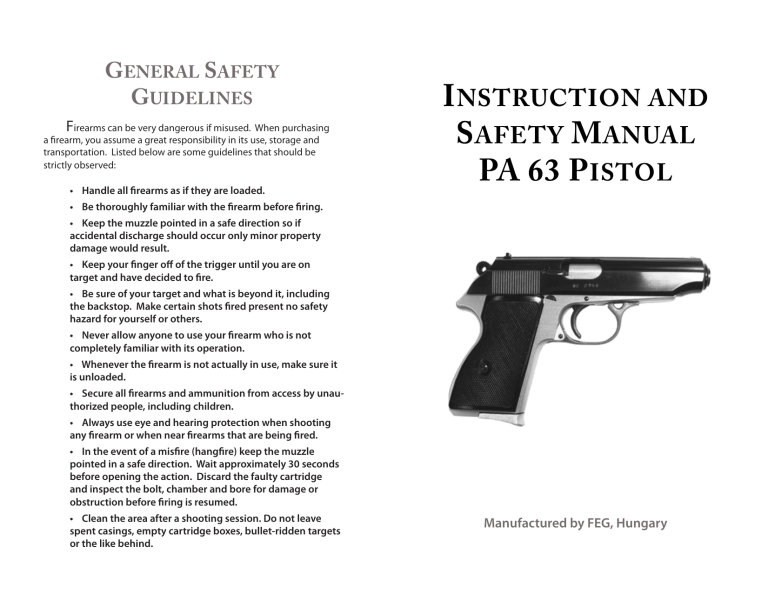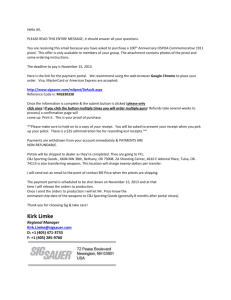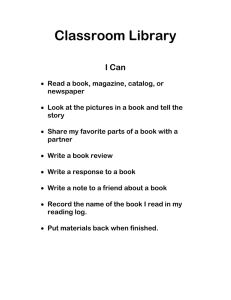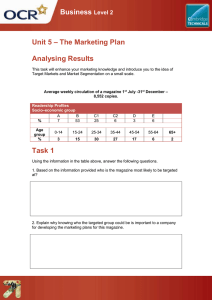
General Safety Guidelines Firearms can be very dangerous if misused. When purchasing a firearm, you assume a great responsibility in its use, storage and transportation. Listed below are some guidelines that should be strictly observed: • Handle all firearms as if they are loaded. • Be thoroughly familiar with the firearm before firing. I nstruction and S afety M anual PA 63 P istol • Keep the muzzle pointed in a safe direction so if accidental discharge should occur only minor property damage would result. • Keep your finger off of the trigger until you are on target and have decided to fire. • Be sure of your target and what is beyond it, including the backstop. Make certain shots fired present no safety hazard for yourself or others. • Never allow anyone to use your firearm who is not completely familiar with its operation. • Whenever the firearm is not actually in use, make sure it is unloaded. • Secure all firearms and ammunition from access by unauthorized people, including children. • Always use eye and hearing protection when shooting any firearm or when near firearms that are being fired. • In the event of a misfire (hangfire) keep the muzzle pointed in a safe direction. Wait approximately 30 seconds before opening the action. Discard the faulty cartridge and inspect the bolt, chamber and bore for damage or obstruction before firing is resumed. • Clean the area after a shooting session. Do not leave spent casings, empty cartridge boxes, bullet-ridden targets or the like behind. Manufactured by FEG, Hungary PA 63 O VERVIEW The PA 63 pistol is a semiautomatic firearm working on the blowback principle. Energy reaction generated by the fired cartridge charge thrusts the slide rearward against the recoil spring until it abuts against the receiver stop. Rearward movement of the slide extracts and ejects the fired cartridge case, cocks the hammer and compresses the recoil spring. The stored energy of the compressed recoil spring then causes the slide to move forward towards the closed position, feeding the next cartridge from the magazine into the chamber. The pistol is now cocked and loaded, requiring only a pull of the trigger to fire the next cartridge and each successive cartridge until the magazine is empty. If the loaded weapon is not already cocked, the shot can be fired by way of the double-action trigger mechanism. The automatic firing pin lock is engaged at all times, except when the trigger is pulled. This feature provides additional safety if the loaded weapon is dropped with the hammer cocked. Under normal circumstances, a shot can only be discharged by intentionally pulling the trigger. When the safety is in “ON” position, the firing pin is shielded against contact from the hammer. WARNING No mechanical safety device ever designed can absolutely prevent firing in all circumstances. The best safety feature of all is careful gun handling. Firearms are deadly weapons and should always be treated with good sense and extreme caution! 10 3 6. Reloading during shooting: when the magazine is empty, the slide is held open (fig. 9) . fig.9 Remove the empty magazine and insert a fresh one. Draw back the slide and allow it to snap forward. The weapon is again loaded and ready to fire (fig. 10). fig. 4 The slide assembly may then be drawn forward and removed from the barrel (fig. 4). The recoils spring may be removed by pulling it off the front of the barrel. No further disassembly is required or recommended for cleaning purposes. Further dismantling is a job for qualified gunsmiths and armourers only. D irections for A ssembly Assembling the pistol is done in reverse order. To reassemble, cock the hammer of the pistol (fig. 5). Replace the recoil spring on the barrel. Note that the smaller end of the spring goes on first. fig.10 7. Unloading the weapon: with the safety “ON”, remove the magazine. Pull the slide to the rear and eject any cartridge left in the chamber. Hold the slide rearward and look in the chamber and magazine to make certain the pistol is empty. 8 fig. 5 5 While holding the pistol in the right hand, place the index finger on the side of the trigger guard. The trigger guard must be its downward position, out of the frame. With the left hand, slip the slide assembly back over the barrel (fig. 6). 3. To chamber the first round: with the safety lever “ON” and your fingers off the trigger, insert the full magazine into the pistol until it is held by the magazine catch. Holding the pistol with the right hand, grasp the grooved surfaces at the rear of the slide with the left hand and pull the slide fully to the rear and release smartly. The slide will snap forward, chambering the first round (fig. 8). Now turn the safety “OFF”. The weapon is loaded, cocked and to fire in single action operation. fig. 6 Pull the slide rearward against the pressure of the recoil spring, until it contracts the end stop and push its rear end down into the frame rails (fig. 6). Release and allow the slide to ease forward (fig. 7). With the right index finger, push sideways on the front of the trigger guard until it snaps back inside the frame. Insert the magazine. fig. 7 fig. 8 1. To remove the magazine: depress the magazine release button in front of the left grip and withdraw the magazine. 4. Use of the safety: to place the manual safety “ON” (in the “SAFE” position, press the safety lever FULLY downward to cover the red dot. This automatically drops the hammer and uncocks the pistol, but the safety shields the firing pin from being struck by the hammer, so the pistol does not fire. Pushing the safety lever upward to expose the red dot will return the safety to the “OFF” (“FIRE”) position, but the hammer remains uncocked. To fire the pistol from the uncocked position, you must either re-cock the hammer with your thumb, or pull the trigger in double-action operation. 2. To load the magazine: press down on the magazine follower with the cartridge case rim. Now slip the cartridge rearward and under the magazine lips. The number of cartridges loaded can be checked through the inspection holes of the magazine body. 5. To fire double-action for a fast first shot when extreme accuracy is not needed, pull the trigger through the entire length of its travel. This automatically cocks and drops the hammer in one motion, firing the pistol. W eapon H andling 6 7 Directions for Disassembly fig. 1 First, point the muzzle in a safe direction and engage the safety in its “SAFE/ON” position. Remove the magazine and look to ensure that there is no cartridge left in the chamber and extract it if there is (fig. 1). While holding the pistol by the grips in the right hand, place the index finger on the right side of the trigger guard. With the left hand, pull the first end of the trigger guard downward out of the fig. 2 frame and apply side pressure to this part with the index finger of the right hand to retain it outside of the receiver (fig. 2). Holding the pistol with the right hand, grasp the grooved surfaces at the rear of the slide with the left hand and pull the slide fully to the rear. Lift the rear end of the slide assembly out of the receiver rails (fig. 3). fig. 3 4 C ARE & C leaning The following steps will keep your pistol in top condition: • Clean the barrel and the chamber with a quality cleaning solvent, using a brush to remove all residue. Wipe dry and lightly reoil with a high-quality gun oil. • Clean all exposed internal surfaces with a brush or with swab and solvent. Pay particular attention to the bolt face where the firing pin protrudes as well as under the extractor. • Lightly lubricate all moving parts, including the contact points of the slide and frame with a light, high-quality gun oil. Wipe away any excess oil. Malfunctions & Stoppages Always keep your pistol clean and properly lubricated. The major ity of malfunctions experienced when firing the PA 63 will be the result of faulty ammunition and/or a damaged or defective magazine. To prevent operation problems, exercise the following pre cautions: • Carefully inspect the pistol and magazine prior to operation to assure proper condition, cleanliness and lubrication. • Use only clean ammunition of the correct type, caliber and loading. Do not use hand-loaded or reloaded ammunition. • Should any parts experience noticeable wear or break, have them repaired or replaced promptly. Transportation & Storage Always keep your firearm unloaded when transporting it to and from shooting activities. Store your firearm separate from ammunition, locked away and out of the reach of children and other inexperienced persons. 9 Stoppages Warning While the PA 63 pistols are reliable, well-constructed quality • Thoroughly clean the firearm and have it inspected by a reputable gunsmith before firing. • Make certain there are no obstructions in the bore. • Be completely familiar with the proper operation of your firearm, especially the safety features. • Use only clean ammunition of the correct type, caliber and loading. Do not use hand-loaded or reloaded ammunition. Technical Specifications Caliber 9 x 18 mm Makarov Mass with unloaded mag (lbs / g) 1.3 lbs / 595 g Overall length (in/mm) Barrel length (in/mm) 7” / 175 mm 4” / 100 mm Number of Riflings Magazine capacity 6 2 7 Solutions Faulty cartridge primer Reload pistol and continue firing Thickening of lubricant or fouling of firing pin channel Inspect and clean pistol Firing emerges only slightly or has nicks on head Have pistol examined by a competent gunsmith Firing pin broken Have part replaced by a competent gunsmith Slide incompletely covers cartridge Slide stopped without reaching extreme forward position, impossible to release hammer Fouling of chamber, frame slots and/or slide Shove slide forward by hitting with hand and continue firing Impaired movement of extractor due to fouling of extractor spring or plunger Inspect and clean pistol Failure to feed cartridge or nonadvance of cartridge from magazine to chamber - Slide is in forward position, but no cartridge in chamber. Fouling of magazine and the pistol’s moving parts Clean pistol and magazine. Reload pistol and continue firing Bent condition of the upper ends of the magazine housing Replace faulty magazine Fouling of moving parts Extract jammed cartridge case and continue firing. If condition persists, clean pistol and magazine and then continue firing Faulty extractor, extractor spring and/or ejector Have pistol examined by a competent gunsmith Misfire Slide in extreme forward position, hammer down, but no shot fired Jamming (pinching) of cartridge case by slide - Cartridge case not ejected out thru opening in slide and jammed between slide and breech face. 11 Troubleshooting Guide weapons, they are pre-owned and out-of-production firearms. Since initial manufacture began in the 1960s, it must be assumed that any pistol purchased now has not been examined by a qualified professional for some time. As with any firearm, certain precautions must be exercised before putting the pistol back into service. Reasons



